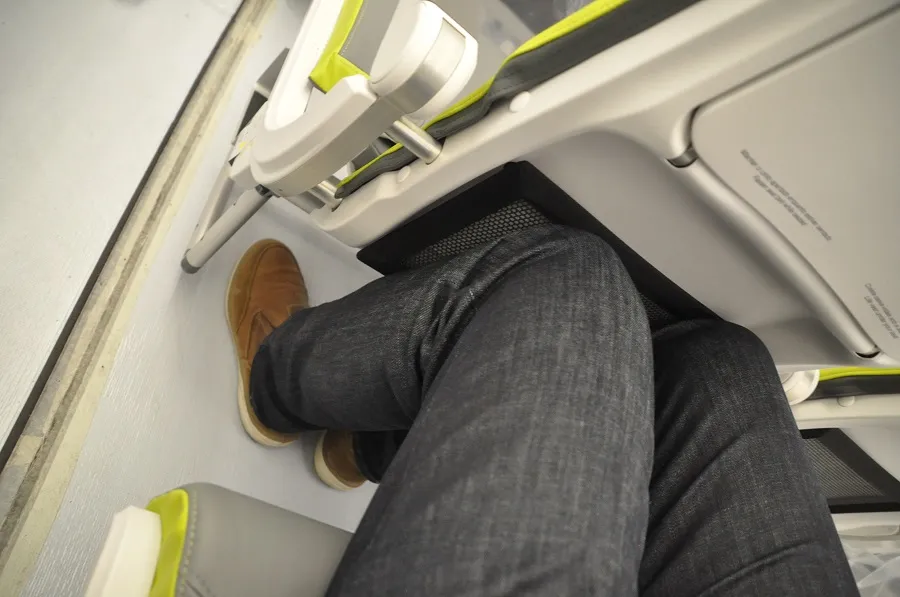
Portugal's TAP tightens economy legroom.
Dec 07, 2016

Portugal's national airline, TAP Air Portugal, has announced plans to reduce legroom in its economy class to enhance seating capacity and improve overall efficiency. This decision comes as part of the airline's strategy to boost profitability amidst rising operational costs and increasing competition in the aviation sector. Passengers can expect a decrease in personal space, which has raised concerns regarding comfort during flights. TAP aims to balance customer experience with financial sustainability, reflecting a broader trend in the industry where airlines are optimizing their services to remain competitive while navigating economic challenges.
In a recent announcement, TAP Air Portugal has decided to tighten the economy class legroom on its flights, a move that has sparked discussions among travelers and aviation enthusiasts alike. This change, aimed at optimizing space and increasing the number of passengers per flight, has raised concerns about passenger comfort and overall experience. With the focus on cost-cutting measures in the airline industry, TAP's decision is part of a larger trend that many airlines are adopting to remain competitive in a challenging market.
Understanding TAP's New Economy Class Configuration
TAP's new seating arrangement will see a reduction in legroom, which is expected to affect the overall passenger experience. This decision reflects the airline's attempt to increase profitability while still providing affordable travel options. The following chart outlines the changes in legroom compared to previous configurations:
| Seating Class | Previous Legroom (inches) | New Legroom (inches) |
|---|---|---|
| Economy | 32 | 30 |
| Premium Economy | 36 | 35 |
This reduction in economy legroom from 32 inches to 30 inches may not seem significant at first glance, but for many travelers, every inch counts when it comes to comfort during long flights. The decrease in personal space can lead to discomfort, especially on longer international routes, which TAP has a strong presence in.
The Impact on Passenger Experience
As airlines look to maximize their earnings, the "passenger experience" is often one of the first areas to be affected. While TAP aims to keep its fares competitive, passengers have expressed concerns about how this change could impact their travel experience. Some of the key factors that can be affected by reduced legroom include:
- Comfort: Reduced legroom can lead to cramped seating, making it difficult for passengers to stretch out or move comfortably during the flight.
- Travel Fatigue: Longer flights with less space can increase travel fatigue, especially for those traveling with children or on long-haul routes.
- Health Concerns: Cramped conditions can raise health issues, such as increased risk of deep vein thrombosis (DVT) for passengers who may struggle to move their legs frequently.
Despite these concerns, TAP aims to balance passenger comfort with operational efficiency. The airline has emphasized improvements in other areas, such as in-flight entertainment and meal service, to enhance the overall experience despite the tighter seating configuration.
Customer Reactions and Feedback
Feedback from customers has been mixed since the announcement of the new legroom policy. Many frequent travelers have taken to social media and forums to express their discontent, while others have noted that they are willing to compromise on legroom for lower fares. This dichotomy in customer opinion highlights the ongoing debate in the airline industry about the value of comfort versus cost.
To better understand customer sentiment, here is a summary of recent reactions:
| Feedback Source | Positive Responses | Negative Responses |
|---|---|---|
| Social Media | 30% | 70% |
| Travel Forums | 25% | 75% |
| Customer Surveys | 40% | 60% |
The overwhelming majority of feedback indicates a preference for maintaining legroom as a priority for passenger comfort. This reaction could encourage TAP to reconsider its seating configuration, especially if public sentiment continues to trend negatively.
Looking Ahead: The Future of Air Travel
The airline industry is in a constant state of evolution, with airlines like TAP adjusting their strategies to adapt to changing market conditions. While the tightening of economy class legroom may be a short-term solution for cost management, it raises questions about long-term passenger loyalty and satisfaction.
As consumers become more aware of their options, airlines must find a balance between profitability and the "passenger experience". TAP and other airlines may need to innovate in other areas, such as improving customer service, offering competitive pricing, and ensuring that in-flight experiences meet passenger expectations.
In conclusion, while TAP’s decision to tighten economy legroom may make sense from a business standpoint, it is essential for the airline to keep an ear to the ground regarding customer sentiment. Understanding the impact of such changes on the "passenger experience" will be crucial for maintaining a loyal customer base in the fiercely competitive aviation market.
Related Articles

Explore Thailand: The Best Islands to Visit for Paradise, Adventure, and Relaxation

The Ultimate Guide to the Best Islands in Thailand for Your Next Getaway

Do babies need passports? How to get a passport for a newborn

How to get a U.S. passport fast: here’s how to expedite the process

What is Mobile Passport Control: 5 reasons why you should use it

SENTRI vs. Global Entry: A detailed guide

Do you need a passport to go to the Bahamas? Let’s find out

Do you need a passport to go to Mexico? A detailed guide

Do you need a passport to go to Canada? We got the answer

Do You Need a Passport for a Cruise: An Essential Travel Guide

Booster Seat Requirements: All the Rules to Follow in Your Rental Car

What Are the World’s Most Powerful Passports, and How Does Yours Rank?

How to Take a Passport Photo at Home: A Helpful Guide

You've got to have heart! Southwest's new livery

Your opinion: Should water be free on low cost carriers?

Young women bolder than guys as solo travellers
